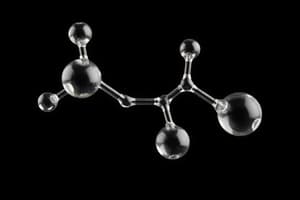Podcast
Questions and Answers
Match the functional groups with their respective types of hydrocarbons:
Match the functional groups with their respective types of hydrocarbons:
Carbon-carbon double bonds = Alkenes Carbon-carbon triple bonds = Alkynes Carbon-carbon single bonds = Alkanes
Match the general formulas with their respective types of hydrocarbons:
Match the general formulas with their respective types of hydrocarbons:
CnH2n = Alkenes CnH2n-2 = Alkynes CnH2n+2 = Alkanes
Match the chemical properties with their respective types of hydrocarbons:
Match the chemical properties with their respective types of hydrocarbons:
Electrophilic addition reactions = Alkenes Acid-base reactions = Alkynes Substitution reactions = Alkanes
Match the reaction types with their respective products:
Match the reaction types with their respective products:
Match the nomenclature rules with their respective types of hydrocarbons:
Match the nomenclature rules with their respective types of hydrocarbons:
Match the physical properties with their respective types of hydrocarbons:
Match the physical properties with their respective types of hydrocarbons:
Match the isomerism types with their respective types of hydrocarbons:
Match the isomerism types with their respective types of hydrocarbons:
Match the reaction types with their respective reactants:
Match the reaction types with their respective reactants:
Flashcards are hidden until you start studying
Study Notes
Alkenes
- Definition: Alkenes are unsaturated hydrocarbons containing one or more carbon-carbon double bonds.
- General Formula: CnH2n
- Nomenclature:
- Prefix: alk- (e.g., eth-, prop-, but-)
- Suffix: -ene (e.g., -ene, -diene, -triene)
- Numbering starts from the end closest to the double bond
- Physical Properties:
- Lower boiling points and densities than alkanes
- Insoluble in water, soluble in organic solvents
- Chemical Properties:
- Electrophilic Addition Reactions: react with electrophiles to form carbocations
- Markovnikov's Rule: in asymmetric alkenes, the electrophile adds to the more substituted carbon
- Stereochemistry: alkenes exhibit cis-trans isomerism due to restricted rotation around the double bond
- Synthesis:
- Dehydrohalogenation: elimination reaction of alkyl halides
- Dehydration: elimination reaction of alcohols
Alkynes
- Definition: Alkynes are unsaturated hydrocarbons containing one or more carbon-carbon triple bonds.
- General Formula: CnH2n-2
- Nomenclature:
- Prefix: alk- (e.g., eth-, prop-, but-)
- Suffix: -yne (e.g., -yne, -diyne, -triyne)
- Numbering starts from the end closest to the triple bond
- Physical Properties:
- Higher boiling points and densities than alkenes
- Insoluble in water, soluble in organic solvents
- Chemical Properties:
- Acid-Base Reactions: alkynes are acidic due to the high electronegativity of the triple bond
- Reduction Reactions: alkynes can be reduced to alkenes or alkanes using hydrogen and catalysts
- Cycloaddition Reactions: alkynes participate in Diels-Alder reactions with dienes
- Synthesis:
- Dehalogenation: reaction of alkyl dihalides with strong bases
- Alkylation: reaction of alkynes with alkyl halides and strong bases
Alkenes
- Unsaturated hydrocarbons with one or more carbon-carbon double bonds
- General formula: CnH2n
- Nomenclature rules:
- Use alk- prefix (e.g., eth-, prop-, but-)
- Use -ene suffix (e.g., -ene, -diene, -triene)
- Numbering starts from the end closest to the double bond
- Physical properties:
- Lower boiling points and densities compared to alkanes
- Insoluble in water, but soluble in organic solvents
- Chemical properties:
- Undergo electrophilic addition reactions to form carbocations
- Follow Markovnikov's Rule in asymmetric alkenes
- Exhibit cis-trans isomerism due to restricted rotation around the double bond
- Synthesis methods:
- Dehydrohalogenation: elimination reaction of alkyl halides
- Dehydration: elimination reaction of alcohols
Alkynes
- Unsaturated hydrocarbons with one or more carbon-carbon triple bonds
- General formula: CnH2n-2
- Nomenclature rules:
- Use alk- prefix (e.g., eth-, prop-, but-)
- Use -yne suffix (e.g., -yne, -diyne, -triyne)
- Numbering starts from the end closest to the triple bond
- Physical properties:
- Higher boiling points and densities compared to alkenes
- Insoluble in water, but soluble in organic solvents
- Chemical properties:
- Acidic due to the high electronegativity of the triple bond
- Undergo reduction reactions to form alkenes or alkanes using hydrogen and catalysts
- Participate in Diels-Alder reactions with dienes
- Synthesis methods:
- Dehalogenation: reaction of alkyl dihalides with strong bases
- Alkylation: reaction of alkynes with alkyl halides and strong bases
Studying That Suits You
Use AI to generate personalized quizzes and flashcards to suit your learning preferences.




